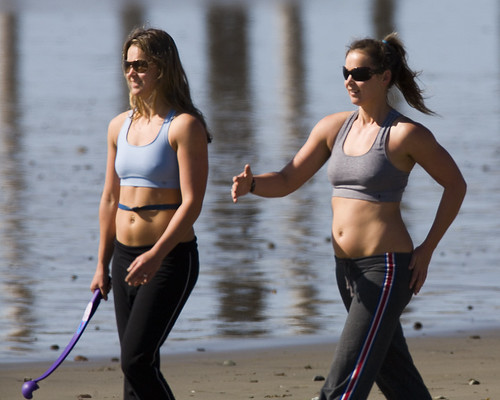Fast Fitness - New Understanding of Hyperlordosis and Disc Injury
Friday, January 22, 2010
Jolie Bookspan, M.Ed, PhD, FAWM
- In my previous studies, I found that overdoing the inward lower spine curve (hyperlordosis) pinches the lower spine like a soda straw. It forces the spine joints, called facets, backward against each other, eventually wearing them, and compresses surrounding soft tissue. After long periods of standing, exercise, and lifting with too much inward curve, lower back pain is not a big surprise or mysterious to fix.
- Hyperlordosis was not previously thought of as a direct herniating force on discs. The major factor was and still is too much forward bending. Weighted flexion (bending forward bearing your body weight) opens the space between vertebrae in back, and over years of slouched sitting and bad bending and lifting forward, presses discs outward through that space creating herniated discs (an injury, not a disease). In my previous work I found that for someone with a disc already herniated, hyperlordosis pinches it, adding pain to the separate problem of the disc. Showing people how to stop standing in hyperlordosis greatly reduced their disc pain. In recent work, I found that hyperlordosis exacerbates, and possibly initiates disc herniation itself.
- My new work is showing that hyperlordosis is a probable mechanism to directly shift disc position. I made a diagram showing the disc injury coming from overarching/ hyperlordosis/ hyperextending the spine that is so common in pop fitness.

Above, Left and center - Drawings of two ways you can stand in hyperlordosis, and the results over time, on the discs.
Above, Right - Actual MRI, comparable to center drawing, shows disc herniation and pinching between lower vertebrae.
Above, Right - Actual MRI, comparable to center drawing, shows disc herniation and pinching between lower vertebrae.
Hyperlordosis (overarching the lower spine) is a spine damaging posture. Hyperlordosis and the pain from it can be changed as easily as moving your spine to a smaller, healthier degree of arch (neutral spine). It is not tightening your abs, just moving your spine, as simply as bending your elbow. Links below tell more.
Related Fun Fitness Fixer:
- I wrote of this in May 2009 when I was on the way to present my work at a medical conference - Comments, A Medical Conference, New Findings on Discs
- How To Spot and Stop Damage from Hyperlordosis - Prevent Back Surgery
- Damage from the opposite problem of injuriously done forward bending - The Cause of Disc and Back Pain and Disc Pain - Not a Mystery, Easy to Fix
---
Read success stories of these methods and send your own.
See if your answers are already here by clicking labels, links in posts, archives, and The Fitness Fixer Index. Subscribe to The Fitness Fixer, click "updates via e-mail" upper right.
For personal medical questions - Replies to Medical Questions. Limited Class space for personal feedback. Top students may earn certification, DrBookspan.com/Academy. Get more in Dr. Bookspan's Books.
Read success stories of these methods and send your own.
See if your answers are already here by clicking labels, links in posts, archives, and The Fitness Fixer Index. Subscribe to The Fitness Fixer, click "updates via e-mail" upper right.
For personal medical questions - Replies to Medical Questions. Limited Class space for personal feedback. Top students may earn certification, DrBookspan.com/Academy. Get more in Dr. Bookspan's Books.
---
Drawing © copyright Dr. Jolie Bookspan. MRI courtesy of ChiroGeek
Walking hyperlordosis photo © by mikebaird
Walking hyperlordosis photo © by mikebaird
Labels: disc, facet joints, facets, fast fitness, fix pain, injury, lordosis, lower back, posture


0 Comments:
Post a Comment
<< Home